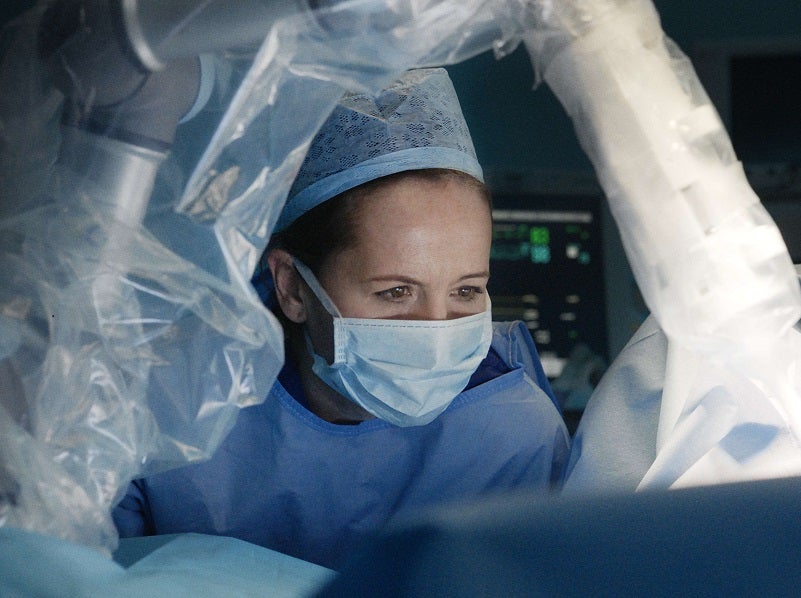
Carrying out a surgical procedure from hundreds of miles away may sound like an exploit from a science fiction novel, but 5G mobile networks are set to bring this technology to a hospital near you in the very near future.
Swedish telecommunications giant Ericsson has been collaborating with King’s College London (KCL) to see how 5G can be applied to surgical procedures, and delivering impressive results.
To operate safely, a surgeon needs to be able to react to physical and visual stimuli in under ten milliseconds. The time traditionally required to compress and decompress video content and tactile feedback over cloud streaming vastly exceeds this, making remote surgery unthinkable in previous years.
But through 5G, surgeons can use specialised haptic feedback gloves developed by Ericsson to operate on a patient via a robotic intermediary, potentially from thousands of miles away. The gloves are able to give a surgeon the same sense of touch as if they were standing over the patient, while video from the operating theatre is streamed directly to them in real-time.
King’s College London senior lecturer in engineering Dr Toktam Mahmoodi says: “The aspects which make 5G a great candidate for things like remote surgery are all things which have been difficult in all the previous generations of networks. Together with extra reliability and the better, faster network you can provide a remote presence in a way that was not possible before.”
It’s the unique aspects of 5G’s cutting-edge infrastructure that allow these procedures to take place. Networks which run on 5G have an incredibly low latency of just a few milliseconds and run at very high speeds, allowing multiple data streams like touch, video and vital signs to be transmitted continuously and simultaneously. The connectivity of 5G also allows for much greater bandwidth usage, while intelligent network slicing separates and prioritises mission-critical functions like machine communication.
On the edge of discovery
“The theoretical limitation of 5G technology is the speed of light and sound,” says Mahmoodi. “Distance is not a barrier, but longer distance is more challenging and will trigger more complex engineering and design.”
Mahmoodi is talking about edge computing. This buzzword-heavy aspect of data processing simply refers to computation which happens right where the data is produced, at the ‘edge’ of the internet of things (IoT) network, instead of relying on cloud processing to do all the work in a distant central data reserve.
Rather than having a centralised remote cloud location do all the work, the data is handled and stored locally in the IoT device itself. Instead of being dependent on an internet connection, the device functions as a standalone network node.
Ericsson head of design and technology Cristian Norlin says: “Edge computing means that you can place computing power and processing power really far out in the network. You can place a lot of critical software that relies on machine learning or computer assisted vision, which is an advantage you didn’t really have before.”
In remote surgery, robotic applications need to be able to analyse data on their own to provide assistance and make sure procedures are completed safely, quickly and accurately. As 5G surgeries move towards greater distances, different edge computing requirements will be needed to sustain the speed and reliability of the connection.
In March 2019, People’s Liberation Army General Hospital (PLAGH) chief physician Ling Zhipei carried out surgery on the brain of a Parkinson’s disease patient in Beijing from the PLAGH Hainan Hospital 3,000km away. Edge computing systems in the surgical devices on either end of the 5G stream are what prevent lag or data shortages as information is transmitted, which could otherwise lead to potentially fatal errors.
Tackling urbanisation
An issue of modern medicine which once seemed insurmountable was that expert surgeons simply couldn’t be based in a geographically convenient location for every patient who could benefit from their care. If a patient could not afford to travel, or became too unwell to do so, this essentially disqualified them from certain kinds of care.
Norlin says: “We know that almost 70% of the world’s population will live in cities in a few decades. It’s safe to assume that a lot of expertise and skills will be focused around the city, but that still means that you have 30% of the world’s population who still pay taxes and still have the right to get access to healthcare.”
Through remote surgery, 5G could tackle this aspect of urbanisation. Rural, resource-limited populations could be given access to specialist surgeries which aren’t currently available in hospitals near their homes, with an expert clinician performing their operation from miles away through a 5G network.
“5G means easier and cheaper access to higher-quality healthcare,” says Mahmoodi. “Today your access to healthcare depends on where you live and through 5G that geographical barrier will be removed.”
The impact of 5G on healthcare isn’t just confined to remote surgery. Remote doctor’s appointments – already an aspect of the modern world through apps like Pushdoctor and Babylon health – could be enhanced by the ability to physically examine a patient. Vodafone’s 5G technology has allowed ambulances to share real time data and 360° images straight to hospital emergency departments to prevent treatment delays upon arrival. It’s even been suggested at 5G could improve patient access to the internet in hospitals, although this is something which remains to be seen. Whether or not remote surgery becomes common practice in community hospitals any time soon, it really does appear that the future is now.



